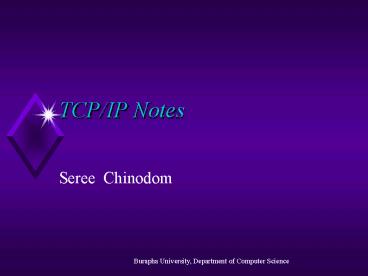TCPIP Notes - PowerPoint PPT Presentation
1 / 10
Title:
TCPIP Notes
Description:
Burapha University, Department of Computer ... 32-bit numbers; usually written out as four 8-bit numbers ... hosts (nodes): ector, lore, www, pc15. 8/19/09 ... – PowerPoint PPT presentation
Number of Views:21
Avg rating:3.0/5.0
Title: TCPIP Notes
1
TCP/IP Notes
- Seree Chinodom
2
TCP/IP Architecture Layers
Applications (mail, news, ftp, web)
Transport (TCP or UDP)
Network (IP)
Data link (Ethernet)
Physical (computers, wires)
3
IPv4 Addresses
- 32-bit numbers usually written out as four
8-bit numbers - Examples 128.10.8.49, 255.255.255.255,
128.10.8.0 - Hierarchy of addresses - classes
- A 0..
- B10..
- C 110..
4
IP Addresses and Routing
- Multicast addresses
- Broadcast addresses
- Routing a packet
- gateways and routers
- hierarchy of routers
- An IP address is static (phone jack), identifies
an outlet in a LAN - Allocated to users by NIC
5
Domain Names
- Aliases of IP addresses an IP address may have
multiple aliases - Structured hierarchically
- top-level domainscom,edu,mil,gov,org,net or
countries ca, jp, de, uk, au, us - organizations purdue, sun, acm
- departments cs, eng, corp
- hosts (nodes) ector, lore, www, pc15
6
Domain Name Servers
- Translate names into IP addresses
- Hierarchy roughly corresponding to domain
hierarchy - Caching names and addresses
- They are not routers
- An application must use the IP address to
communicate
7
TCP End-point Identifiers
- Ports mailboxes for communication, muliplexing
and demultiplexing data - Privileged ports 1-1024 well-known ports 80,
21, 25, 79 - TCP connections (host1port1,host2port2)
- For the system a combination (hostport)
identifies application an application may use
many ports for multiple connections
8
Client/Server Model
- One program (server) starts and waits for
requests another program (client) initiates
communication - Servers listen for incomming packets and
connections clients connect to the servers - Servers can service multiple requests clients
may connect to many servers
9
Servers and Daemons
- Servers start first - ideally they are always
running (in background) - Daemons - stand-alone or running under inetd
- inetd starts a server based on a port in a
configuration file - Web server are usually stand-alone
10
Things To Configure
- Host - IP address(es), gateway(s) - I.e., routes,
name(s), domain name server(s) - Application
- Server - port(s) to listen to, inetd entry(ies),
handling multiple requests - Clients - servers (hosts and/or ports) to connect
to































